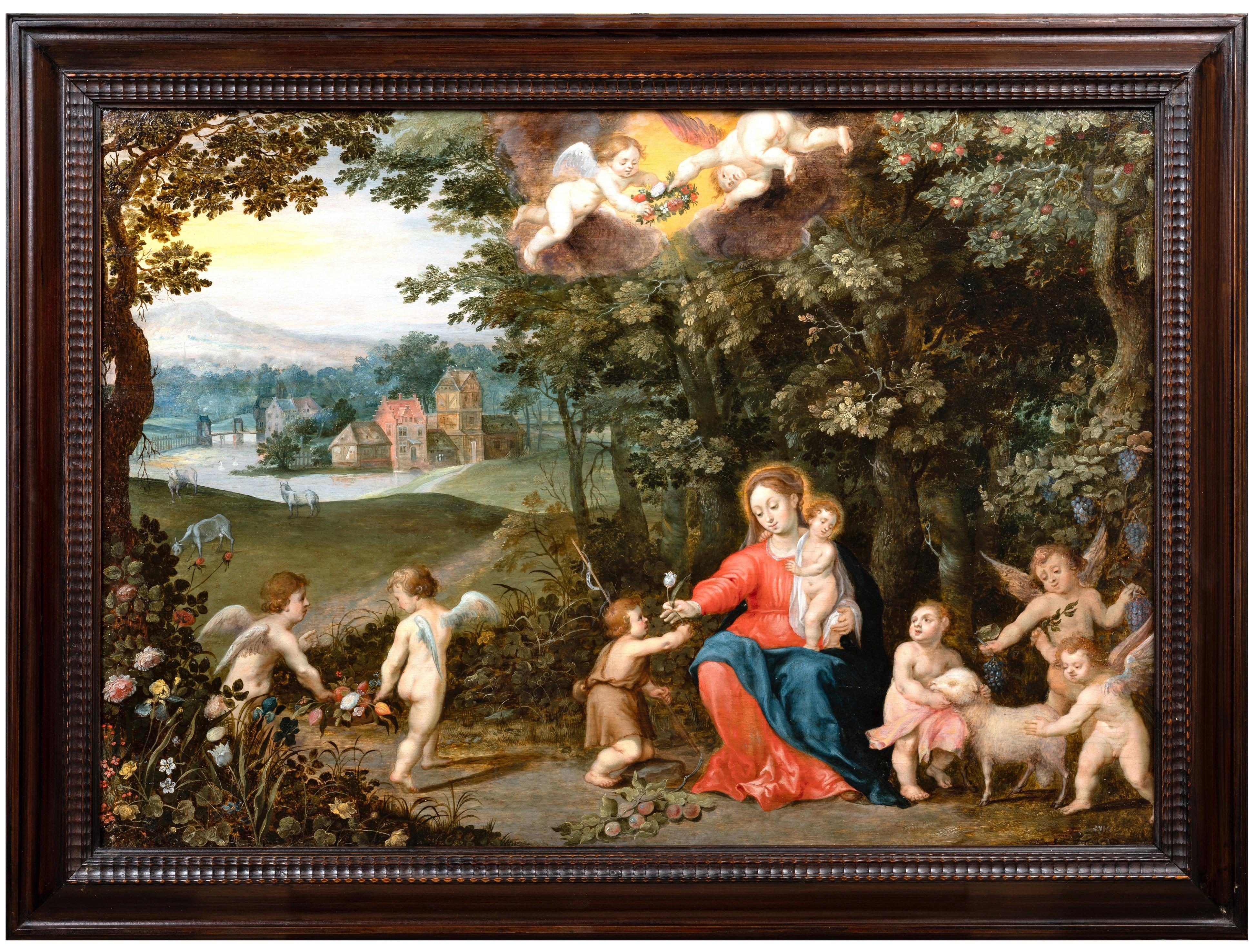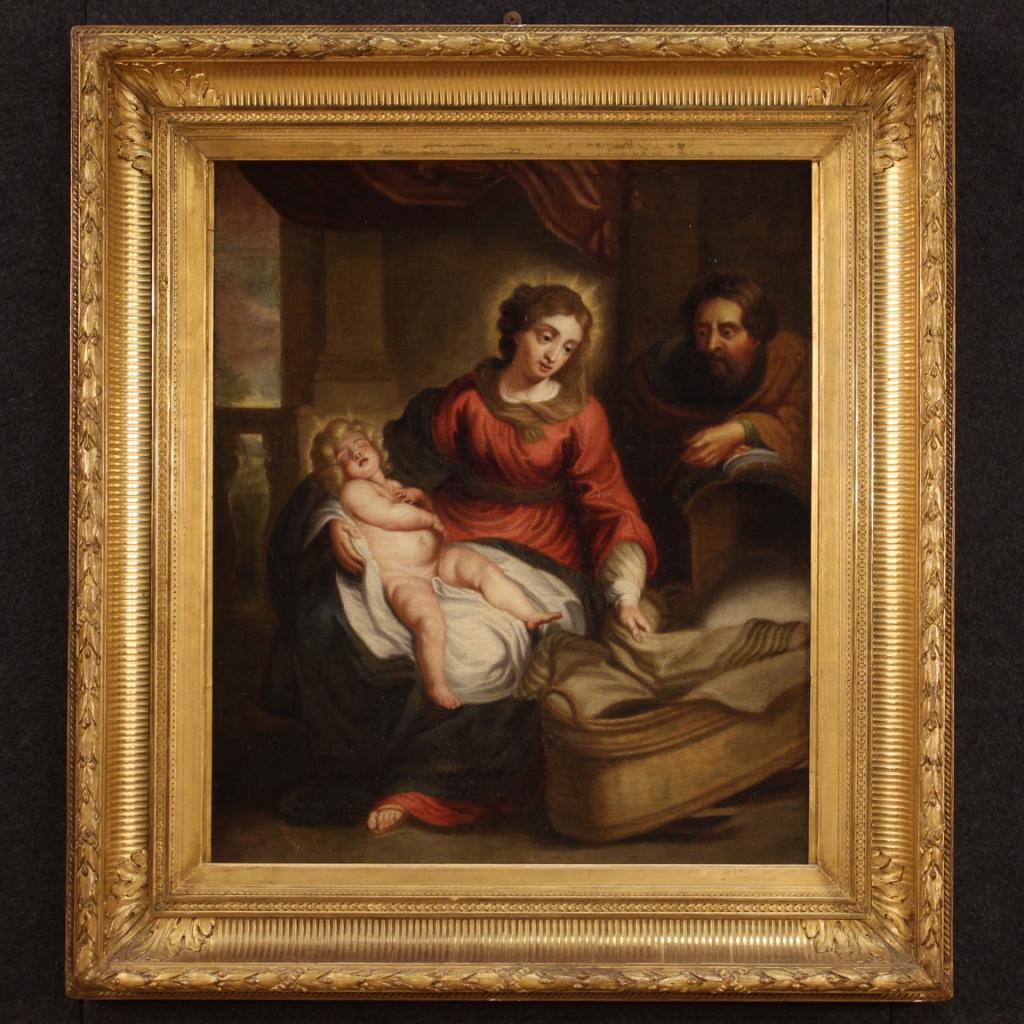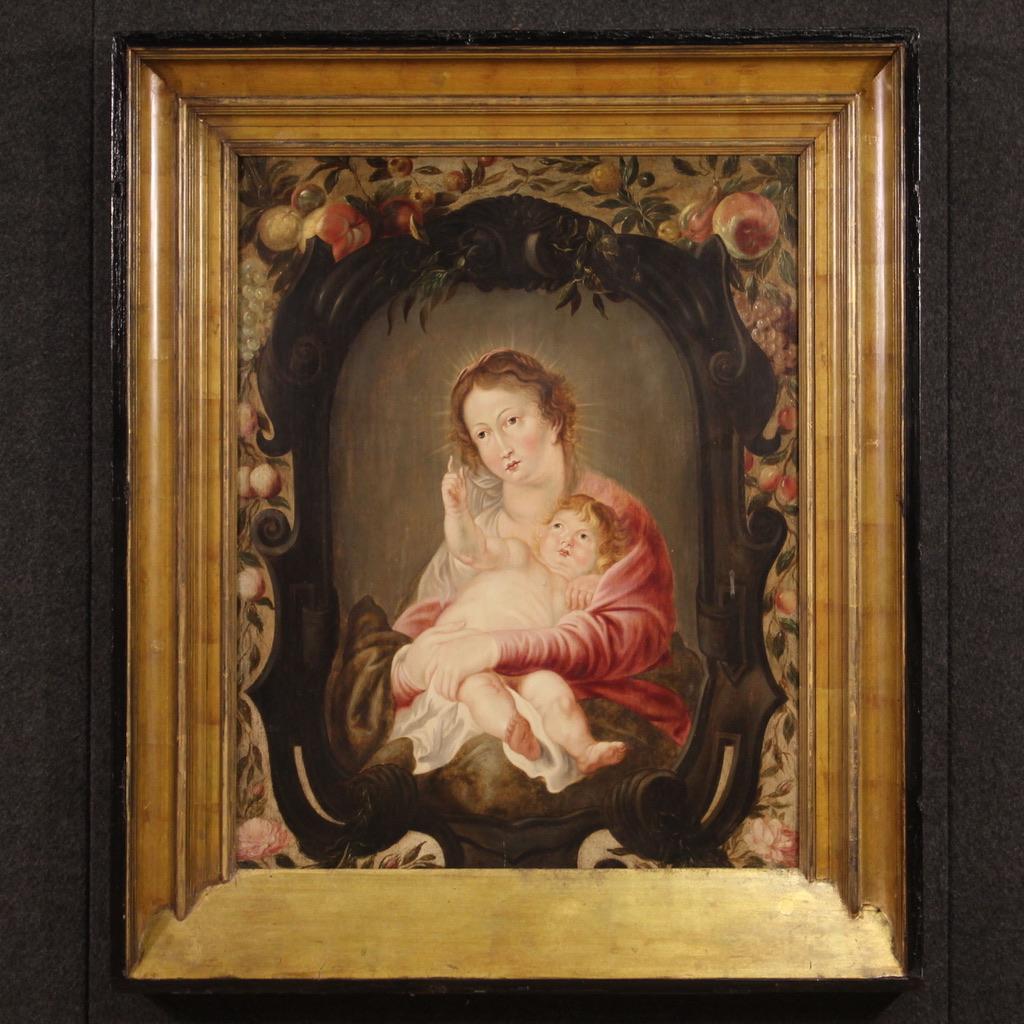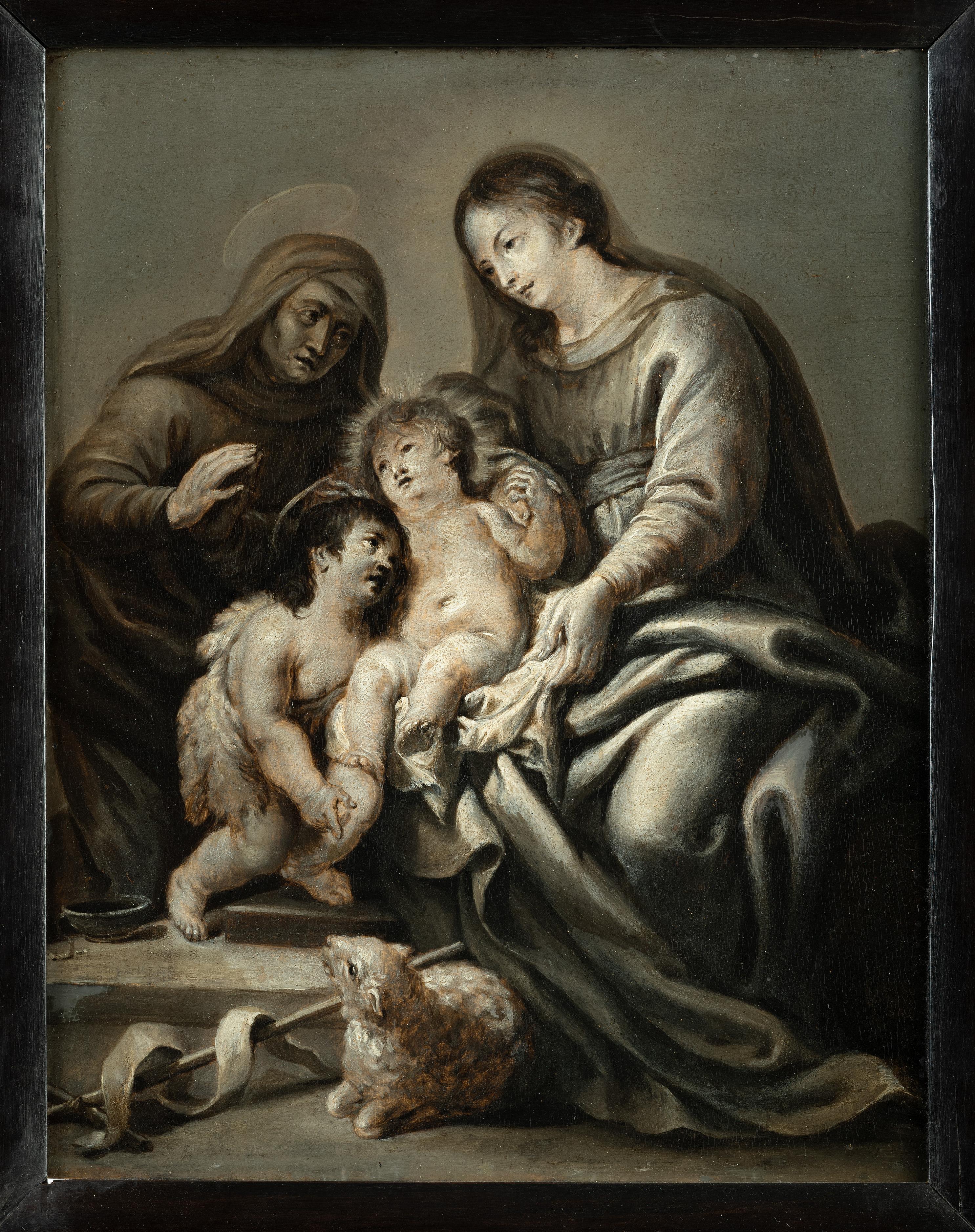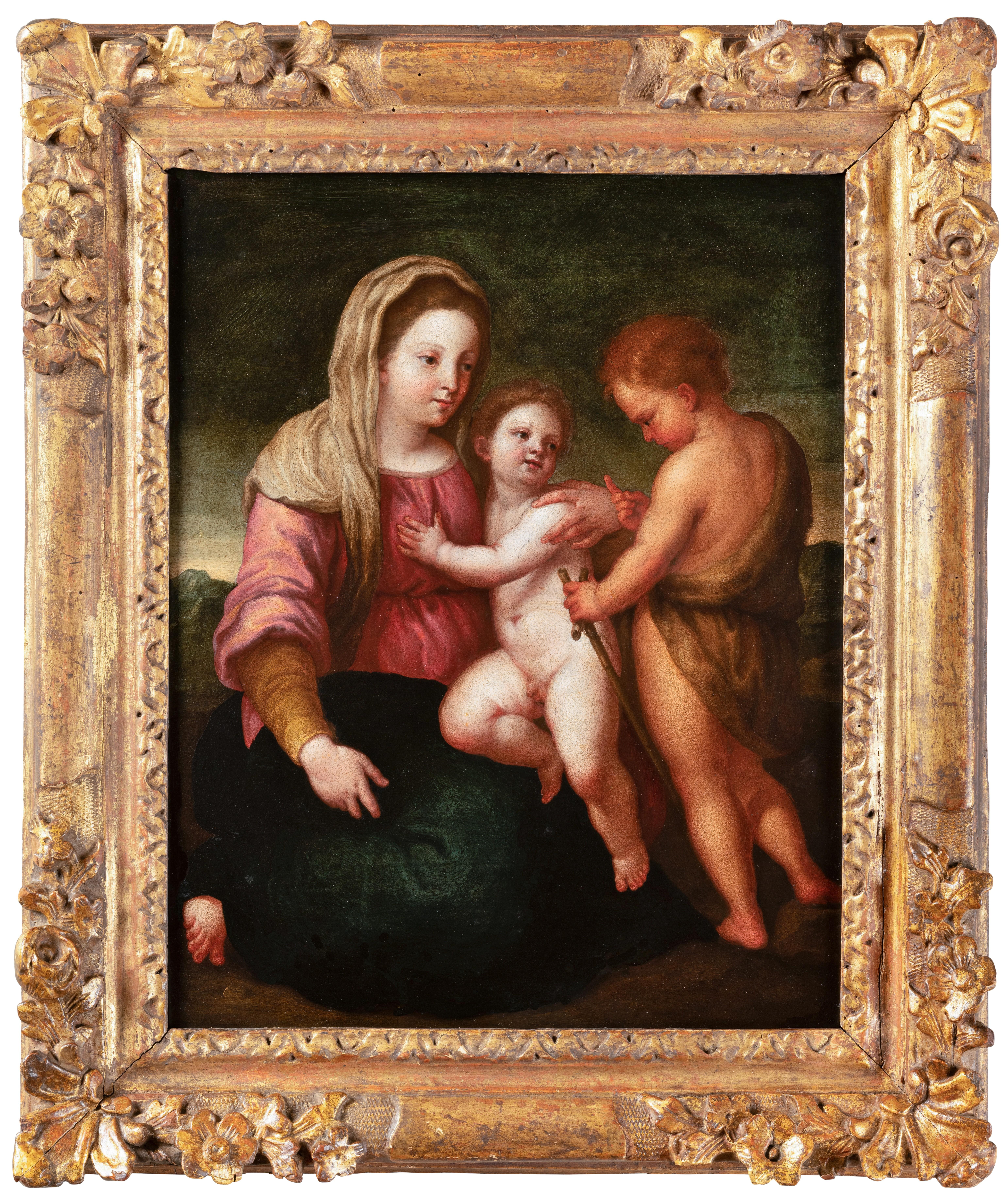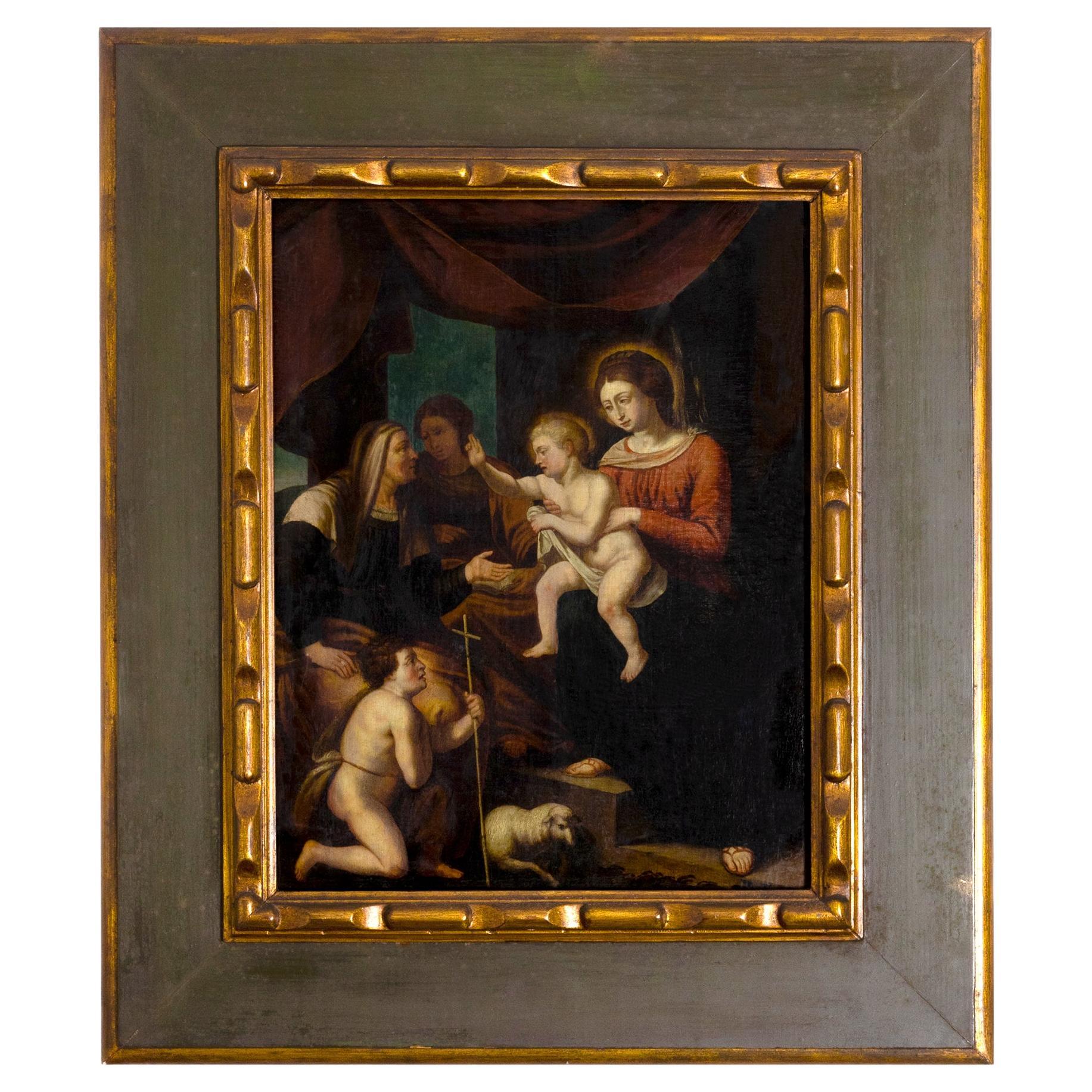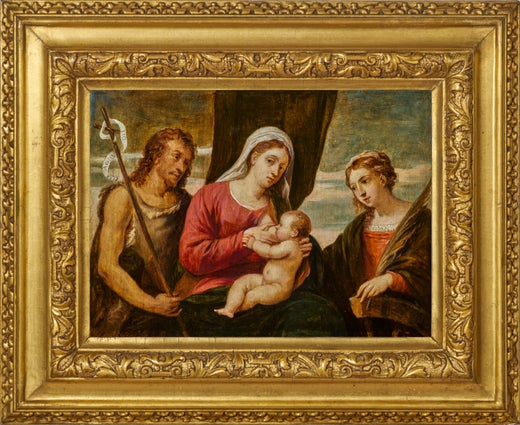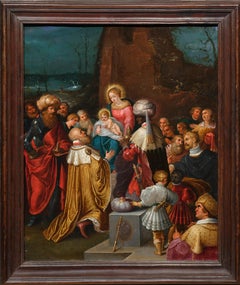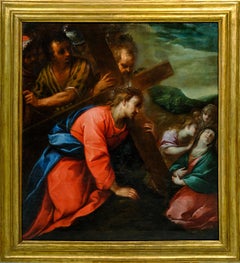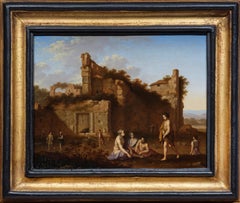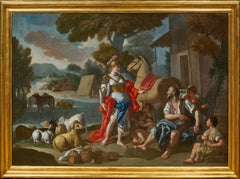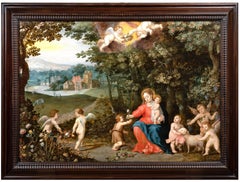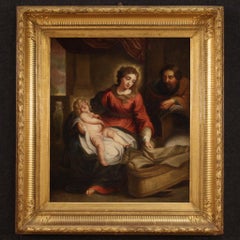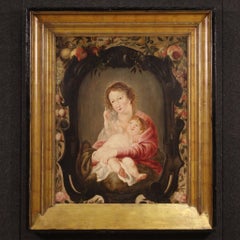Items Similar to Virgin and Child, a paiting by David Teniers the Younger after Palma Vecchio
Want more images or videos?
Request additional images or videos from the seller
1 of 12
David Teniers the YoungerVirgin and Child, a paiting by David Teniers the Younger after Palma Vecchioca. 1655
ca. 1655
$43,700.77
£32,512.94
€36,500
CA$60,884.14
A$66,265.01
CHF 34,788.53
MX$800,578.07
NOK 436,634.53
SEK 411,694.72
DKK 277,918.61
About the Item
Provenance:
Dukes of Marlborough Collection, Blenheim Palace until its sale at Christie's London on 26 July 1886 (lot 172)
English private collection until its sale at Christie's London on 11 December 1992 (lot 363)
Erna Weidinger Collection (1923 - 2021) - Austria
Literature :
Georg Scharf - A list of the pictures in Blenheim Palace - Catalogue raisonné Part 2 - London 1862 (page 166 - number 199 "after Palma Giovane")
Charles Davies - A collection of one Hundred and Twenty Paintings by David Teniers (from Blenheim Palace) - The property of His grace the Duke of Malborough. On exhibition at Mr. Davis' Galleries - London 1884 (page 30 - number 199; "after Palma Giovane")
This painting is presented in the "Blenheim" type frame. Such frames were used to uniformly frame the 120 pasticci by Teniers at Blenheim Palace.
This 'pasticcio' by Teniers, a preparation for the engraving by Jan Popels depecting the Virgin and Child after Palma Vecchio, is moving in many ways. It is the last remaining evidence of the existence of this painting, which has now disappeared. It is one of 246 copies of old master paintings from the collection of Archduke Leopold William of Habsburg, painted by David Teniers to illustrate the Theatrum Pictorium, the first illustrated catalogue of European art history published in 1660. Like half of them, it then became part of the collections of the Dukes of Malborough at Blenheim until the sale of this ensemble in 1886. It is still displayed in its Blenheim-style frame, a model that was created in the 18th century to present these paintings in a homogeneous way.
1. David Teniers II, painter to Archduke Leopold William of Habsburg
Son of David Teniers the Elder and Dymphna de Wilde, David Teniers II probably received his first painting lessons from his father, before continuing his training in the studio of Adriaen Brouwer.
In 1632 he became a member of the Antwerp Guild, specialising in small religious formats and genre paintings. He became friends with Jan Brueghel the Elder, known as de Velours, and in 1637 he married hisdaughter Anne. In 1647 he worked for Archduke Leopold William of Habsburg, who governed the Spanish Netherlands, and in 1651 he followed him to Brussels as a court painter.
His responsabilities included the management of the Archduke's art collection and the production of an illustrated catalogue: The Theatrum Pictorium which was published in 1660. For this catalogue he painted small copies of Italian, mainly Venetian, paintings from the Archduke's collection. These paintings served as models for engravers and were called "pasticci". This collection of paintings was bequeathed by Leopold William to his nephew, Emperor Leopold 1st , and today it forms the core of the collections of the Kunsthistorisches Museum in Vienna.
2. The last testimony of a Palma Vecchio painting now lost
The engraving by Jan Popels allows us to identify this painting as a work by Palma Vecchio, although it had long been attributed to his grand-nephew Palma il Giovane. This painting is known from the successive inventories made by the Habsburgs: it was numbered 230 in the collection of Archduke Leopold-Guillaume and measured 60 x 100 cm. Donated in 1662 to Emperor Leopold 1er, it appears in the inventory of the Stallburg Palace in Vienna in 1735 and in a final inventory in 1772, before being lost.
This painting was probably bought, like many other Venetian paintings (including, for example, Giovanni Bellini's Bathing Woman painted around 1515), from the heirs of the Duke of Hamilton, who had himself bought it from Bartolomeo della Nove or Nicolo Renier.
Painted around 1510-1512, this painting is the only known example in which Palma Vecchio depicts a theme that was very common in the 15th century, that of the Virgin breastfeeding the Child Jesus. She is accompanied on her right by St. John the Baptist (recognisable by his animal skin and the phylactery "ecce agnus dei", i.e. "here is the Lamb of God", hanging from his cross-shaped staff) and on her left by St. Catherine of Alexandria, with the palm of martyrdom in her left hand, resting on the wheel miraculously broken during her martyrdom.
3. Jan Popel's engraving and the 'Blenheim' frame
In the absence of Palma Vecchio’s painting, it is difficult to compare Teniers' execution of this pasticcio with the original. We can however highlight the subtle way in which he was able to render the Venetian atmosphere of the painting and the delicacy of the child suckling at his mother's breast under the tender eyes of the two saints.
Jan Popel's engraving (last photo in the gallery – not for sale), which is very close in size to our pasticcio, faithfully reproduces the composition, obviously on an inverted basis. The message on the phylactery that appeared on the Palma Vecchio painting was erased during the engraving, as it could not be read in reverse.
What is very interesting about this pasticcio, apart from the testimony of a lost work, is that it retains its 'Blenheim' frame in which the entire collection purchased by John Churchill (1650 - 1722), the first Duke of Marlborough, was framed in the 18th century. These paintings were displayed in the early nineteenth century in Blenheim’s billiard room, where they remained until their sale in 1886.
4. The Theatrum Pictorium and the pasticci
Leopold William of Habsburg (1614 - 1662) was the last son of Emperor Ferdinand II of Habsburg and Maria Anna of Bavaria and the brother of Emperor Ferdinand III. Governor General of the Spanish Netherlands from 1647 to 1656, he built up one of the most splendid collections of paintings of his time, in which Venetian masterpieces predominated.
David Téniers II, who entered his service in 1647, supervised the publishing venture of the Theatrum Pictorium by painting small replicas of paintings from the collection to serve as "modello" (preparatory sketches) for the engravings in this book, which was published after the Archduke's return to Vienna in 1660. Most of the pasticci were made in a format relatively close to the one we are presenting (around 17 x 23 cm), but some are smaller (usually portraits measuring around 17 x 12 cm) and a few are larger, up to 22.9 x 31.3 cm (Adam and Eve after the Expulsion from the Earthly Paradise from the Courtauld Institute in London).
Pasticci have always been a subject of collecting and today the largest group of pasticci is held at the Courtauld Institute Gallery in London (fourteen) while the Kunsthistorisches Museum in Vienna, which holds the majority of the Archduke's paintings, holds seven of them. Other sets of several pasticci are also held at the National Gallery of Ireland in Dublin, the Wallace Collection in London, the Metropolitan Museum of Art in New York, the Princetown University Art Museum, the Glasgow Museum, the Stedelijk Museum in Lakenhal, Leiden, and the Musée du Louvre in Paris, while a number of other institutions hold a single pasticcio.
Based upon the Blenheim inventories, the marks No. 18 and No. 192 visible on the verso of our panel were used to designate first the pictorial genre to which the painting belongs, and second its inventory number.
Main bibliographical references :
David Teniers and the Theatre of Painting (collective work) - Courtauld Institute of Art Gallery - 2006
Philip Rylands - Palma Vecchio - Cambridge University Press 1972
- Creator:David Teniers the Younger (1610 - 1690, Flemish)
- Creation Year:ca. 1655
- Dimensions:Height: 11.13 in (28.28 cm)Width: 13.57 in (34.47 cm)
- Medium:
- Movement & Style:
- Period:1750-1759
- Condition:Oil on monoxyl oak panel 6 11/16”x 8 15/16” (17 x 22.7 cm ) – Framed : 11 1/8”x 13 9/16” (28.3 x 34.4 cm).
- Gallery Location:PARIS, FR
- Reference Number:1stDibs: LU1568211458292
David Teniers the Younger
David Teniers the Younger was a 17th-century Flemish painter known for his luminous depictions of peasant life. His work was greatly influenced by the tavern scenes of Adriaen Brouwer and the fluid paint handling of Peter Paul Rubens. Born on December 15, 1610 in Antwerp, Belgium, he was the son of the artist David Teniers the Elder, with whom he studied as a youth. Notably, Teniers later married the daughter of the painter Jan Brueghel the Elder. In the early 1630s, the Haarlem-based painter Brouwer moved to Antwerp, Teniers exposure to his low-genre paintings was a turning point in his career. Over the following decades, he enjoyed a popular reputation around Europe. Though most of his works were modest in scale, he was a prolific artist and is thought to have completed some 2,000 paintings over the course of his career. Teniers died on April 25, 1690 in Brussels, Belgium. Today, his work can be found in the Louvre in Paris, the National Gallery of Art in London, the Hermitage Museum in St. Petersburg, and the Rijksmuseum in Amsterdam, among others.
About the Seller
5.0
Vetted Professional Seller
Every seller passes strict standards for authenticity and reliability
Established in 2020
1stDibs seller since 2021
10 sales on 1stDibs
- ShippingRetrieving quote...Shipping from: PARIS, France
- Return Policy
Authenticity Guarantee
In the unlikely event there’s an issue with an item’s authenticity, contact us within 1 year for a full refund. DetailsMoney-Back Guarantee
If your item is not as described, is damaged in transit, or does not arrive, contact us within 7 days for a full refund. Details24-Hour Cancellation
You have a 24-hour grace period in which to reconsider your purchase, with no questions asked.Vetted Professional Sellers
Our world-class sellers must adhere to strict standards for service and quality, maintaining the integrity of our listings.Price-Match Guarantee
If you find that a seller listed the same item for a lower price elsewhere, we’ll match it.Trusted Global Delivery
Our best-in-class carrier network provides specialized shipping options worldwide, including custom delivery.More From This Seller
View AllThe Adoration of the Magi, an early painting by Frans Francken II (1581 - 1682)
By Frans Francken II
Located in PARIS, FR
We would like to thank Dr. Ursula Härting who, after examining the work, confirmed the autograph nature of this painting by Frans Francken the Younger in a certificate issued on December 9, 2024.
In this previously unpublished painting coming from a French private collection, Frans Francken the Younger tackles one of his favorite themes: the adoration of the Magi, the wise men who come from the East to adore the infant Jesus in Bethlehem, Judea. This theme was often taken up by the artist, but this version, which can be dated around 1610, is one of the earliest interpretations.
1. Frans Francken the Younger, "a surprisingly inventive painter".
Frans Francken the Younger is the best-known member of an extended artistic family that worked in Antwerp from the late sixteenth to the late seventeenth century. Born in 1581, he almost certainly studied with his father, Frans Francken the Elder (c. 1542-1616), before becoming a master in the Antwerp Saint Luke's Guild in 1605. In 1627 he became a member of the Antwerp archers' guild De Oude Handboog.
Francken was an extremely productive and imaginative artist who specialized in expressively rendered small-scale religious and mythological scenes. He also painted larger altarpieces for Catholic churches. His depictions of collectors' cabinets introduced a genre of painting that influenced several artists, including Jan Brueghel the Elder...
Category
1610s Old Masters Figurative Paintings
Materials
Copper
Christ Falling on the Way to Calvary, a painting by Carlo Francesco Nuvolone
Located in PARIS, FR
This painting by Carlo Francesco Nuvolone, the great Lombard master of the mid-seventeenth century, is striking for its dazzling composition and the brilliant colors of Christ's tuni...
Category
1640s Old Masters Figurative Paintings
Materials
Canvas, Oil
Gathering in antique Ruins, a monogrammed painting by Jan van Haensbergen
By Jan Van Haensbergen
Located in PARIS, FR
Jan van Haensbergen was a painter of the Dutch Golden Age and a pupil of Cornelius van Poelenburgh (Utrecht 1594 - 1667). The painting we are presenting is inspired by Poelenburgh’s landscapes from his Italian sojourn. The dreamlike atmosphere of this Gathering in antique ruins appealed to us. Against a backdrop of antique ruins, three draped characters (perhaps bathers) are sitting in a circle, greeting a fourth character walking towards them.
Their tranquility contrasts with the bustle of the other characters in the background. They constitute a vivid illustration of otium, this leisure time that allows us to realize our full potential. With this Arcadian landscape, Jan van Haensbergen invites us in turn to leave the hustle and bustle of everyday life behind, to take a break, to enjoy the present moment chatting with close friends…
1. Jan van Haensbergen, a landscape and portrait painter of the Dutch Golden Age
Jan van Haensbergen was born in 1642 in Gorinchem, a town in southern Holland to the east of Rotterdam. He was a pupil of Cornelius van Poelenburgh, and began by painting landscapes inspired by those of his master, in an Italianate style. Between 1668 and 1669, he was registered at the Guild of Saint Luke in Utrecht.
In 1669, he moved to The Hague, where he joined the Confrérie Pictura, an artist society founded in 1656. His portraits, which became his main activity as a painter after settling in The Hague, were strongly influenced by Caspar Netscher (Prague or Heidelberg 1639 - The Hague 1684), whom he met in The Hague and whose son Constantijn became his son-in-law by marrying his daughter Magdalena.
In addition to his work as an artist, Van Haensbergen was also an art dealer, probably helped by his appointment as Dean of the Confrérie Pictura, where he also teached.
2. Description of the artwork and related paintings
This painting seems to us to be a kind of allegory of otium, that quiet bliss promised by Epicurus. It might even evoke an Epicurean proverb: "It is better to lie on the naked ground and be at ease, than to have a golden carriage and a rich table and be worried" .
Three draped young people - two men and a woman in the background - are seated in a circle, greeting a fourth figure walking towards them, hair disheveled and body draped in a towel as if drying off after a bath, indicating the need for prior purification to fully enjoy this rest. Their nonchalance contrasts with the bustle of the various characters in the background.
The composition is punctuated by successive diagonals, and opens onto a landscape on the right, with a succession of mountainous planes. This painting is typical of the Italianate works produced by Van Haensbergen in the 1660s under the influence of Cornelis van Poelenburgh...
Category
17th Century Old Masters Landscape Paintings
Materials
Oak, Oil
Erminia and the Shepherds, a painting by Francesco de Mura (Napoli 1696 - 1782)
By Francesco de Mura
Located in PARIS, FR
In this masterly painting, Francesco de Mura presents the meeting of Erminia and the shepherds, a famous episode taken from the seventh canto of Torquato Tasso's Jerusalem Delivered....
Category
1760s Old Masters Figurative Paintings
Materials
Canvas, Oil
Allegory of Chastity, a drawing attributed to G. Porta with great provenance
Located in PARIS, FR
This magnificent drawing from the Venetian Renaissance intrigues us in many ways. It depicts an allegorical composition whose meaning partly escapes us: a veiled figure seated on a stone bench (which we have identified as Chastity), seems to be turning away from a woman's bust beside her, below which are two rabbits, a traditional allegory of fertility, but also sometimes of lust.
This drawing, executed on blue paper, undoubtedly belongs to the Venetian Renaissance. The inscriptions on the back of the old mounting board indicate the various attributions considered by its last owner, the British painter and art historian Sir Lawrence Gowing. We have retained the attribution to Giuseppe Porta proposed by art historian John Arthur Gere as the most relevant.
We were incredibly fortunate to find a hexagonal frame of a very similar format for this drawing, the upper corners of which were formerly cut (irregularly). This 17th-century Dutch frame comes from an aristocratic collection in Lombardy, and creates a kind of fascinating chase around this Venetian drawing...
Category
16th Century Figurative Drawings and Watercolors
Materials
Chalk
Diana and Actaeon, a Mannerist painting after Joseph Heintz the Elder
Located in PARIS, FR
This painting seduced us with its rich colors. Depicting Diana and her companions surprised by Actaeon, it was inspired by an engraving by Aegidius Sadeler II after a painting by Jos...
Category
17th Century Old Masters Nude Paintings
Materials
Oil, Wood Panel
You May Also Like
17th c. Antwerp studio of J. Brueghel & H. van Balen - The Virgin with Child
Located in PARIS, FR
Workshop of Jan Brueghel the Younger (1601-1678) & Hendrick van Balen (Antwerp, 1575 – 1632)
17th century Antwerp School
The Virgin and Child ...
Category
1630s Old Masters Figurative Paintings
Materials
Oil
18th Century Oil on Canvas Flemish Framed Religious Painting Holy Family, 1750
Located in Vicoforte, IT
Antique Flemish painting from the 18th century. Framework oil on canvas depicting religious subject Holy family of good pictorial quality. Nice sized and pleasantly decorated framewo...
Category
1750s Figurative Paintings
Materials
Canvas, Oil
$5,745 Sale Price
20% Off
17th Century Oil on Panel Flemish Religious Painting Madonna with Child, 1670
Located in Vicoforte, IT
Antique Flemish panel from the first half of the 17th century. Oil painting depicting a splendid Madonna with child inside a niche surrounded by a garland of masterfully painted flow...
Category
1670s Figurative Paintings
Materials
Oil, Wood
$8,618 Sale Price
20% Off
Old Master Painting, Flemish Baroque Grisaille, Cornelis Schut, Mary with Child
Located in Greven, DE
Cornelis Schut, atrributed to
(1597 - Antwerp - 1655)
Mary with Child, St. Elisabeth and John the Baptist en grisaille
Oil on wood, 33,5 x 26,5 cm
Co...
Category
17th Century Baroque Figurative Paintings
Materials
Oil
Virgin with Child & St John, oil on marble, late 16th century Florentine school
By Andrea Del Sarto
Located in PARIS, FR
Virgin with Child & St John, late 16th c. Florentine school
Late 16th c. Florentine school
Virgin with Child and St John the Baptiste
Oil on white marble,
h. 41,5 cm, w. 32 cm
17th L...
Category
16th Century Old Masters Figurative Paintings
Materials
Marble
Flemish School Painting, Adoration of the Child, 18th Century, Religious Art
Located in Lisbon, PT
This 18th-century Flemish oil on wood painting depicts the moment of adoration of the Child Jesus, in the loving arms of the Virgin Mary.
Kneeling at their feet is the young Saint J...
Category
Antique 18th Century Dutch Baroque Paintings
Materials
Wood
$6,922 Sale Price
20% Off
More Ways To Browse
Virgin And Child
Billiard Room
18th Century Italian Religious Paintings
Child 18th Century Painting Portrait
St John The Baptist
Lamb Of God
18th Century Oil Paintings For Sale
Adam And Eve Oil Painting
Master Copy Painting
Virgin Child Painting
Old Master Copies Painting
Agnus Dei
Giovanni Bellini
Jan Brueghel The Elder
Virgin And Child Painting
David Elder
Oil Paitings
St Catherine Of Alexandria
